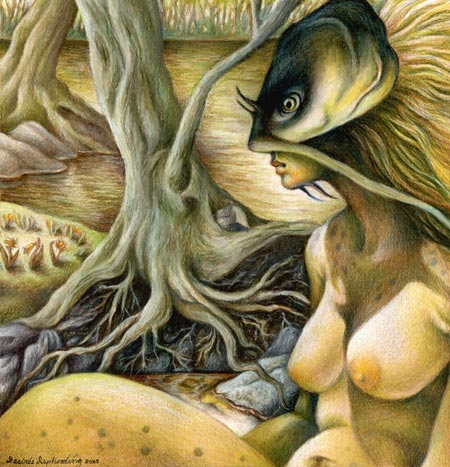

Even though the lake itself is man-made, I do not believe that she is a new inhabitant of the area; she very likely resided in the immediate vicinity when only the stream, which was dammed to create the lake, ran through the valley. I think it is very possible though that her haunt expanded as a result of the building of the lake. The larger body of water allows her a greater vantage point from which to guard and observe. As a creature of the dark, weed-choked waters of the lake, it seemed entirely befitting that she revealed herself as a CatfishWoman in this image. Specifically, her form and coloring are based on the Channel Catfish (Ictalurus punctatus), a species which actually does live in the lake. Sleek and scaleless, she is adept at slipping below the surface without leaving a solitary ring in her wake. Interestingly, another common name for this fish is "lady cat."
At a time when I had temporarily set this piece aside with only the foreground and midground completed since I couldn't determine the proper background setting, a strange verse suddenly came into my head:
follow the Catfish Woman
to the edge of the ravine
but beware the ring of trout lilies
all is not as it seems
In European folklore, rings of fertile grass or mushrooms were said to mark the circular paths of Faery revelry. That same body of folklore also cautions against tresspassing the boundary of a fairy ring or otherwise disturbing it. People who dared to pass into the ring sometimes never reemerged on the other side, and if they did return to the land of mortals it was often at great cost, for time passes strangely in Faery: a youth could step into the circle, but a haggard old man steps out; someone strong and able could enter, but the one who exits could be withered and lame. Scientifically speaking, the phenomenon historically called fairy rings are the result of a spreading fungus which grows outwards in a radial fashion. This little rhyme finally gave me the inspiration to finish the piece. In this case, the boundary of the faery ring is marked with Trout Lilies (Erythronium americanum). These flowers bloom in early spring at the actual locations represented in the mid- and background of this piece.
A few years ago, a local artist had created an impromptu sculpture out of driftwood in the lake which appeared from the road high above to be the silhouette of some large serpentine creature gracefully arching its back above the surface while its head curled gently out of the ripples to peer around. It reminded me a great deal of the famous photographs of the supposed Loch Ness Monster, and based on that similarity, I personally dubbed the sculpture the "Nock Ness Monster." Unfortunately, the sculpture was dismantled/destroyed some time ago. While attempting to do some research on my area, I stumbled across the webpage of a storyteller who used to live by the lake, and in one of his stories he mentions the elusive Nock Ness Monster:
"As I leave the lily pads behind, I notice swirls of muddy water rising from the bottom alongside my kayak. My paddle must be coming close enough to the bottom to cause this disturbance. As I pay more attention the swirls are just off the bow, ahead of where my paddle moves the water. I'm not sure what the cause of this can be, until I catch a glimpse of lake bottom, and of a twenty inch catfish that is stirring the silt as it touches down in its search for supper. At about this same time, something large almost breeches the surface just ahead of my craft, actually pushing the filamentous weeds here above the surface. Another catfish? Or the Nock Ness monster?"I do not know whether this man had seen the sculpture and had come to similar conclusions about it or if he too sensed some Other Presence in the area, but apparently the Nock Ness Monster lives outside of my own head and is known to others in some guise. It's especially intriguing to me that this author associates the Nock Ness with catfish. I wonder if my CatfishWoman and the Nock Ness Monster are one and the same creatures, perceived through varying lenses. Considering her ambivalent nature, it wouldn't surprise me if some people might view her as a monster of sorts.
© Desirée Isphording 2008 - all rights reserved -